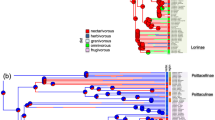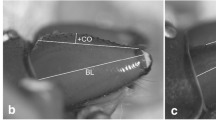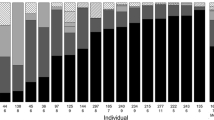Abstract
Competition-driven feeding niche separation is assumed to be an important driver of the morphological divergence of co-occurring animal species. However, despite a strong theoretical background, empirical studies showing a direct link between competition, diet divergence and specific morphological adaptations are still scarce. Here we studied the early steps of competition-driven eco-morphological divergence in two closely related passerines: the common nightingale (Luscinia megarhynchos) and the thrush nightingale (Luscinia luscinia). Our aim was to test whether previously-observed divergence in bill morphology and habitat in sympatric populations of both species is associated with dietary niche divergence. We collected and analysed data on (1) diet, using both DNA metabarcoding and visual identification of prey items, (2) habitat use, and (3) bill morphology in sympatric populations of both nightingale species. We tested whether the species differ in diet composition and whether there are any associations among diet, bill morphology and habitat use. We found that the two nightingale species have partitioned their feeding niches, and showed that differences in diet may be partially associated with the divergence in bill length in sympatric populations. We also observed an association between bill length and habitat use, suggesting that competition-driven habitat segregation could be linked with dietary and bill size divergence. Our results suggest that interspecific competition is an important driver of species’ eco-morphological divergence after their secondary contact, and provide insight into the early steps of such divergence in two closely related passerine species. Such divergence may facilitate species coexistence and strengthen reproductive isolation between species, and thus help to complete the speciation process.



Similar content being viewed by others
Data availability
Sequencing data are available from the European Nucleotide Archive under the study accession number: PRJEB37727. Metadata to the individual sequence samples are provided in the Supplementary Table S7. All other data are attached as Supplementary Material.
References
Abdi H, Valentin D (2007) Multiple correspondence analysis. Mult Corresp Anal Soc Sci 2:651–666
Adams DC, Rohlf FJ (2000) Ecological character displacement in Plethodon: biomechanical differences found from a geometric morphometric study. Proc Natl Acad Sci 97:4106–4111. https://doi.org/10.1073/pnas.97.8.4106
Alberdi A, Aizpurua O, Bohmann K et al (2019) Promises and pitfalls of using high-throughput sequencing for diet analysis. Mol Ecol Resour 19:327–348. https://doi.org/10.1111/1755-0998.12960
Albrecht T, Opletalová K, Reif J et al (2019) Sperm divergence in a passerine contact zone: indication of reinforcement at the gametic level. Evolution 73:202–213. https://doi.org/10.1111/evo.13677
Arlettaz R, Christe P, Schaub M (2017) Food availability as a major driver in the evolution of life-history strategies of sibling species. Ecol Evol 7:4163–4172. https://doi.org/10.1002/ece3.2909
Becker J (1995) Sympatric occurrence and hybridization of the Thrush Nightingale (Luscinia luscinia) and the Nightingale (Luscinia megarhynchos) at Frankfurt (Oder), Brandenburg. Vogelwelt 116:109–118
Benjamini Y, Hochberg Y (1995) Controlling the false discovery rate: a practical and powerful approach to multiple testing. J R Stat Soc 57:289–300. https://doi.org/10.1111/j.2517-6161.1995.tb02031.x
Boncoraglio G, Saino N (2007) Habitat structure and the evolution of bird song: a meta-analysis of the evidence for the acoustic adaptation hypothesis. Funct Ecol 21:134–142. https://doi.org/10.1111/j.1365-2435.2006.01207.x
Brandl R, Kristín A, Leisler B (1994) Dietary niche breadth in a local community of passerine birds: an analysis using phylogenetic contrasts. Oecologia 98:109–116. https://doi.org/10.1007/BF00326096
Brown WL, Wilson EO (1956) Character displacement. Syst Zool 5:49–64. https://doi.org/10.2307/2411924
Callahan BJ, McMurdie PJ, Rosen MJ et al (2016) DADA2: high-resolution sample inference from Illumina amplicon data. Nat Methods 13:581–583. https://doi.org/10.1038/nmeth.3869
Calvemr MC, Woolledd RD (1982) A technique for assessing the taxa, length, dry weight and energy content of the arthropod prey of birds. Aust Wildl Res 9:293–301. https://doi.org/10.1071/WR9820293
Cramp S, Brooks DJ (1992) Handbook of the birds of Europe, the Middle East and North Africa. The birds of the western Palearctic, vol VI. Oxford University Press, Warblers
Davies TJ, Meiri S, Barraclough GT, Gittleman LJ (2007) Species co-existence and character divergence across carnivores. Ecol Lett 10:146–152. https://doi.org/10.1111/j.1461-0248.2006.01005.x
Derryberry EP, Seddon N, Claramunt S et al (2012) Correlated evolution of beak morphology and song in the neotropical woodcreeper radiation. Evolution 66:2784–2797. https://doi.org/10.1111/j.1558-5646.2012.01642.x
Diniz-Filho JAF, Bini LM, Hawkins BA (2003) Spatial autocorrelation and red herrings in geographical ecology. Glob Ecol Biogeogr 12:53–64. https://doi.org/10.1046/j.1466-822X.2003.00322.x
Drury JP, Tobias JA, Burns KJ et al (2018) Contrasting impacts of competition on ecological and social trait evolution in songbirds. PLoS Biol 16:1–23. https://doi.org/10.1371/journal.pbio.2003563
Elbrecht V, Leese F (2017) Corrigendum: validation and development of COI metabarcoding primers for freshwater macroinvertebrate bioassessment. Front Environ Sci 5:1–11. https://doi.org/10.3389/fenvs.2017.00038
Felice RN, Tobias JA, Pigot AL, Goswami A (2019) Dietary niche and the evolution of cranial morphology in birds. Proc R Soc B Biol Sci 286:20182677. https://doi.org/10.1098/rspb.2018.2677
Fossog BT, Ayala D, Acevedo P et al (2014) Habitat segregation and ecological character displacement in cryptic African malaria mosquitoes. Evol Appl 8:326–345. https://doi.org/10.1111/eva.12242
Freed LA, Medeiros MCI, Cann RL (2016) Multiple reversals of bill length over 1.7 million years in a Hawaiian bird lineage. Am Nat 187:363–371. https://doi.org/10.1086/684787
Friedman NR, Harmáčková L, Economo EP, Remeš V (2017) Smaller beaks for colder winters: thermoregulation drives beak size evolution in Australasian songbirds. Evolution 71:2120–2129. https://doi.org/10.1111/evo.13274
Gill FB (2006) Ornithology, 3rd edn. Macmillan Publishers Limited, New York
Grant PR (1981) Speciation radiation and the adaptive of Darwin’s finches. Am Sci 69:653–663
Grant PR, Grant RB (2002) Unpredictable evolution in a 30 year study of Darwin’s finches. Science 296:707–711. https://doi.org/10.1126/science.1070315
Greenberg R, Cadena V, Danner RM, Tattersall G (2012) Heat loss may explain bill size differences between birds occupying different habitats. PLoS ONE 7:1–9. https://doi.org/10.1371/journal.pone.0040933
Hódar JA (1997) The use of regression equations for the estimation of prey length and biomass in diet studies of insectivore vertebrates. Misc Zool 20:1–10
Hongshan J, Rong L, Shou-Wei D, Shuifang Z (2014) Skewer: a fast and accurate adapter trimmer for next-generation sequencing paired-end reads. BMC Bioinform 15:1–12. https://doi.org/10.1186/1471-2105-15-182
Kadlec T, Štrobl M, Hanzelka J et al (2018) Differences in the community composition of nocturnal Lepidoptera between native and invaded forests are linked to the habitat structure. Biodivers Conserv 27:2661–2680. https://doi.org/10.1007/s10531-018-1560-8
Kverek P, Storchová R, Reif J, Nachman MW (2008) Occurrence of a hybrid between the Common Nightingale (Luscinia megarhynchos) and the Thrush Nightingale (Luscinia luscinia) in the Czech Republic confirmed by genetic analysis. Sylvia 44:17–26
Legendre P, Andersson MJ (1999) Distance-based redundancy analysis: testing multispecies responses in multifactorial ecological experiments. Ecol Monogr 69:1–24
Legendre P, Fortin M-J, Borcard D (2015) Should the Mantel test be used in spatial analysis? Methods Ecol Evol 6:1239–1247. https://doi.org/10.1111/2041-210X.12425
Leisler B, Winkler H (2015) Evolution of island warblers: beyond bills and masses. J Avian Biol 46:236–244. https://doi.org/10.1111/jav.00509
Losos JB (2011) Lizards in an evolutionary tree: ecology and adaptive radiation of anoles, vol 10. University of California Press, Berkeley
Luther D, Greenberg R (2014) Habitat type and ambient temperature contribute to bill morphology. Ecol Evol 4:699–705. https://doi.org/10.1002/ece3.911
MacArthur R, Levins R (1967) The limiting similarity, convergence, and divergence of coexisting species. Am Nat 101:377–385. https://doi.org/10.1086/282505
McMurdie PJ, Holmes S (2013) Phyloseq: an R package for reproducible interactive analysis and graphics of microbiome census data. PLoS ONE 8:e61217. https://doi.org/10.1371/journal.pone.0061217
Miller ET, Wagner SK, Harmon LJ, Ricklefs RE (2017) Radiating despite a lack of character: ecological divergence among closely related, morphologically similar honeyeaters (Aves: Meliphagidae) co-occurring in arid Australian environments. Am Nat 189:E14–E30. https://doi.org/10.1086/690008
Mönkkönen M, Devictor V, Forsman JT et al (2017) Linking species interactions with phylogenetic and functional distance in European bird assemblages at broad spatial scales. Glob Ecol Biogeogr 26:952–962. https://doi.org/10.1111/geb.12605
Mořkovský L, Janoušek V, Reif J et al (2018) Genomic islands of differentiation in two songbird species reveal candidate genes for hybrid female sterility. Mol Ecol 27:949–958. https://doi.org/10.1111/mec.14479
Naguib M, Amrhein V, Kunc HP (2004) Effects of territorial intrusions on eavesdropping neighbors: communication networks in nightingales. Behav Ecol 15:1011–1015. https://doi.org/10.1093/beheco/arh108
Navalón G, Bright JA, Marugán-Lobón J, Rayfield EJ (2018) The evolutionary relationship among beak shape, mechanical advantage, and feeding ecology in modern birds. Evolution 73:422–435. https://doi.org/10.1111/evo.13655
Olsen AM (2017) Feeding ecology is the primary driver of beak shape diversification in waterfowl. Funct Ecol 31:1985–1995. https://doi.org/10.1111/1365-2435.12890
Peres-Neto PR, Legendre P, Dray S, Bocard D (2006) Variation partitioning of species data matrices: estimation and comparison of fraction. Ecology 87:2614–2625
Pfennig KS, Pfennig DW (2009) Character displacement: ecological and reproductive responses to a common evolutionary problem. Q Rev Biol 84:253–276. https://doi.org/10.1086/605079
Pfennig DW, Rice AM, Martin RA (2007) Field and experimental evidence for competition’s role in phenotypic divergence. Evolution 61:257–271. https://doi.org/10.1111/j.1558-5646.2007.00034.x
Pianka ER (1973) The structure of lizard communities. Annu Rev Ecol Syst 4:53–74. https://doi.org/10.1146/annurev.es.04.110173.000413
Poulin B, Leeebvre G, Mcneil R (1994a) Diets of land birds from northeastern Venezuela. Condor 96:354–361. https://doi.org/10.2307/1369320
Poulin B, Lefebvre G, McNeil R (1994b) Effect and efficiency of tartar emetic in determining the diet of tropical land birds. Condor 96:98–104. https://doi.org/10.2307/1369067
Reif J, Jiran M, Reifová R et al (2015) Interspecific territoriality in two songbird species: potential role of song convergence in male aggressive interactions. Anim Behav 104:131–136. https://doi.org/10.1016/j.anbehav.2015.03.016
Reif J, Reifová R, Skoracka A, Kuczyński L (2018) Competition-driven niche segregation on a landscape scale: evidence for escaping from syntopy towards allotopy in two coexisting sibling passerine species. J Anim Ecol 87:774–786. https://doi.org/10.1111/1365-2656.12808
Reifová R, Kverek P, Reif J (2011a) The first record of a female hybrid between the Common Nightingale (Luscinia megarhynchos) and the Thrush Nightingale (Luscinia luscinia) in nature. J Ornithol 152:1063–1068. https://doi.org/10.1007/s10336-011-0700-7
Reifová R, Reif J, Antczak M, Nachman MW (2011b) Ecological character displacement in the face of gene flow: evidence from two species of nightingales. BMC Evol Biol 11:138. https://doi.org/10.1186/1471-2148-11-138
Renner SC, Baur S, Possler A et al (2012) Food preferences of winter bird communities in different forest types. PLoS ONE 7:1–10. https://doi.org/10.1371/journal.pone.0053121
Rybinski J, Sirkiïa PM, McFarlane SE et al (2016) Competition-driven build-up of habitat isolation and selection favoring modified dispersal patterns in a young avian hybrid zone. Evolution 70:2226–2238. https://doi.org/10.1111/evo.13019
Schaffers AP, Raemakers IP, Sykora KW, Braak C (2008) Arthropod assemblages are best predicted by plant. Ecology 89:782–794. https://doi.org/10.1890/07-0361.1
Schluter D (2000) Ecological character displacement in adaptive radiation. Am Nat 156:S4–S16. https://doi.org/10.1086/303412
Schluter D, McPhail JD (1992) Ecological character displacement and speciation in sticklebacks. Am Nat 140:85–108. https://doi.org/10.1086/285404
Schoener TW (1974) Resource partitioning in ecological communities. Science 185:27–39. https://doi.org/10.1126/science.185.4145.27
Seehausen O (2006) African cichlid fish: a model system in adaptive radiation research. Proc R Soc B Biol Sci 273:1987–1998. https://doi.org/10.1098/rspb.2006.3539
Sorjonen J (1986) Mixed singing and interspecific territoriality-consequences of secondary contact of two ecologically and morphologically similar nightingale species in Europe. Ornis Scand 17:53–67. https://doi.org/10.2307/3676753ER
Sottas C, Reif J, Kuczyński L, Reifová R (2018) Interspecific competition promotes habitat and morphological divergence in a secondary contact zone between two hybridizing songbirds. J Evol Biol 31:914–923. https://doi.org/10.1111/jeb.13275
Souriau A, Kohoutová H, Reif J et al (2018) Can mixed singing facilitate coexistence of closely related nightingale species? Behav Ecol 29:925–932. https://doi.org/10.1093/beheco/ary053
Spellerberg IF, Fedor PJ (2003) A tribute to Claude Shannon (1916–2001) and a plea for more rigorous use of species richness, species diversity and the ‘Shannon-Wiener’ index. Glob Ecol Biogeogr 12:177–179. https://doi.org/10.1046/j.1466-822X.2003.00015.x
Stoffel MA, Nakagawa S, Schielzeth H (2017) rptR: repeatability estimation and variance decomposition by generalized linear mixed-effects models. Methods Ecol Evol 8:1639–1644. https://doi.org/10.1111/2041-210X.12797
Storchová R, Reif J, Nachman MW (2010) Female heterogamety and speciation: reduced introgression of the Z chromosome between two species of nightingales. Evolution 64:456–471. https://doi.org/10.1111/j.1558-5646.2009.00841.x
Stuart YE, Losos JB (2013) Ecological character displacement: glass half full or half empty? Trends Ecol Evol 28:402–408. https://doi.org/10.1016/j.tree.2013.02.014
Taberlet P, Bonin A, Zinger L, Coissac E (2018) Environmental DNA: for biodiversity research and monitoring. Oxford University Press, Oxford
Tatner P (1983) The diet of urban magpies Pica pica. Ibis 125:97–107. https://doi.org/10.1111/j.1474-919X.1983.tb03086.x
Tattersall GJ, Arnaout B, Symonds MRE (2017) The evolution of the avian bill as a thermoregulatory organ. Biol Rev 92:1630–1656. https://doi.org/10.1111/brv.12299
Tobias JA, Cornwallis CK, Derryberry EP et al (2014) Species coexistence and the dynamics of phenotypic evolution in adaptive radiation. Nature 506:359–363. https://doi.org/10.1038/nature12874
Vokurková J, Petrusková T, Reifová R et al (2013) The causes and evolutionary consequences of mixed singing in two hybridizing songbird species (Luscinia spp.). PLoS ONE 8:e60172. https://doi.org/10.1371/journal.pone.0060172
Wang Q, Garrity GM, Tiedje JM, Cole JR (2007) Naïve Bayesian classifier for rapid assignment of rRNA sequences into the new bacterial taxonomy. Appl Environ Microbiol 73:5261–5267. https://doi.org/10.1128/AEM.00062-07
Wang Y, Naumann U, Wright ST, Warton DI (2012) Mvabund—an R package for model-based analysis of multivariate abundance data. Methods Ecol Evol 3:471–474. https://doi.org/10.1111/j.2041-210X.2012.00190.x
Winkelmann K, Genner MJ, Takahashi T, RuBer L (2014) Competition-driven speciation in cichlid fish. Nat Commun 5:1–8. https://doi.org/10.1038/ncomms4412
Wolf JBW, Harrod C, Brunner S et al (2008) Tracing early stages of species differentiation: ecological, morphological and genetic divergence of Galápagos sea lion populations. BMC Evol Biol 8:1–14. https://doi.org/10.1186/1471-2148-8-150
Wood EM, Swarthout SEB, Hochachka WM et al (2016) Intermediate habitat associations by hybrids may facilitate genetic introgression in a songbird. J Avian Biol. https://doi.org/10.1111/jav.00771
Acknowledgements
We would like to thank Abel Souriau and Lucie Baránková for the field assistance and Hanka Pinkasová for her work on DNA isolation. Petr Klimeš and Petr Kozel assisted with identification of ants and beetles, respectively. We acknowledge the CF Genomics of CEITEC supported by the NCMG research infrastructure (LM2015091 funded by MEYS CR) for their support with obtaining scientific data presented in this paper. Access to computing and storage facilities owned by parties and projects contributing to the National Grid Infrastructure MetaCentrum, provided under the programme ‘Projects of Large Infrastructure for Research, Development, and Innovations’ (LM2010005), is greatly appreciated. The study was supported by a student grant of the Grant Agency of Charles University (6462/2017) to C.S., the Czech Science Foundation (Grant No. 18–14325S) and the Charles University grant PRIMUS/19/SCI/008 to R.R. Work of K.S. was supported by European Research Council project BABE 805189.
Author information
Authors and Affiliations
Contributions
RR, JR, JK and CS conceived ideas and designed methodology; CS, JR and TO collected the data in the field; LS and KS performed laboratory analyses; CS, JK and JR analysed the data; RR, CS, JR and JK wrote the manuscript. All authors contributed critically to the drafts and gave final approval for publication.
Corresponding author
Ethics declarations
Conflict of interest
The authors declare no conflicts of interest.
Human and animal rights
This work was carried out in accordance with ethical animal research requirements of Poland according to Polish law (the Act On the Protection of Animals used for Scientific or Educational Purposes, 15.01.2015, item 266, implementing Directive 2010/63/EU of the European Parliament and of the European Council of 22.09.2010). Experiments on birds were approved by the Local Ethic Committee for Scientific Experiments on Animals in Poznań, Poland (permission No. 17/2015) and the Polish National Nature Conservation Authority (permission no. DZP-WG.6401.03.123.2017.dl.3). Ringing was performed under license No. 114225895 of the national ringing centre in Gdańsk (Ornithological Station of the Polish Academy of Sciences).
Additional information
Publisher's Note
Springer Nature remains neutral with regard to jurisdictional claims in published maps and institutional affiliations.
Electronic supplementary material
Below is the link to the electronic supplementary material.
Rights and permissions
About this article
Cite this article
Sottas, C., Reif, J., Kreisinger, J. et al. Tracing the early steps of competition-driven eco-morphological divergence in two sister species of passerines. Evol Ecol 34, 501–524 (2020). https://doi.org/10.1007/s10682-020-10050-4
Received:
Accepted:
Published:
Issue Date:
DOI: https://doi.org/10.1007/s10682-020-10050-4




